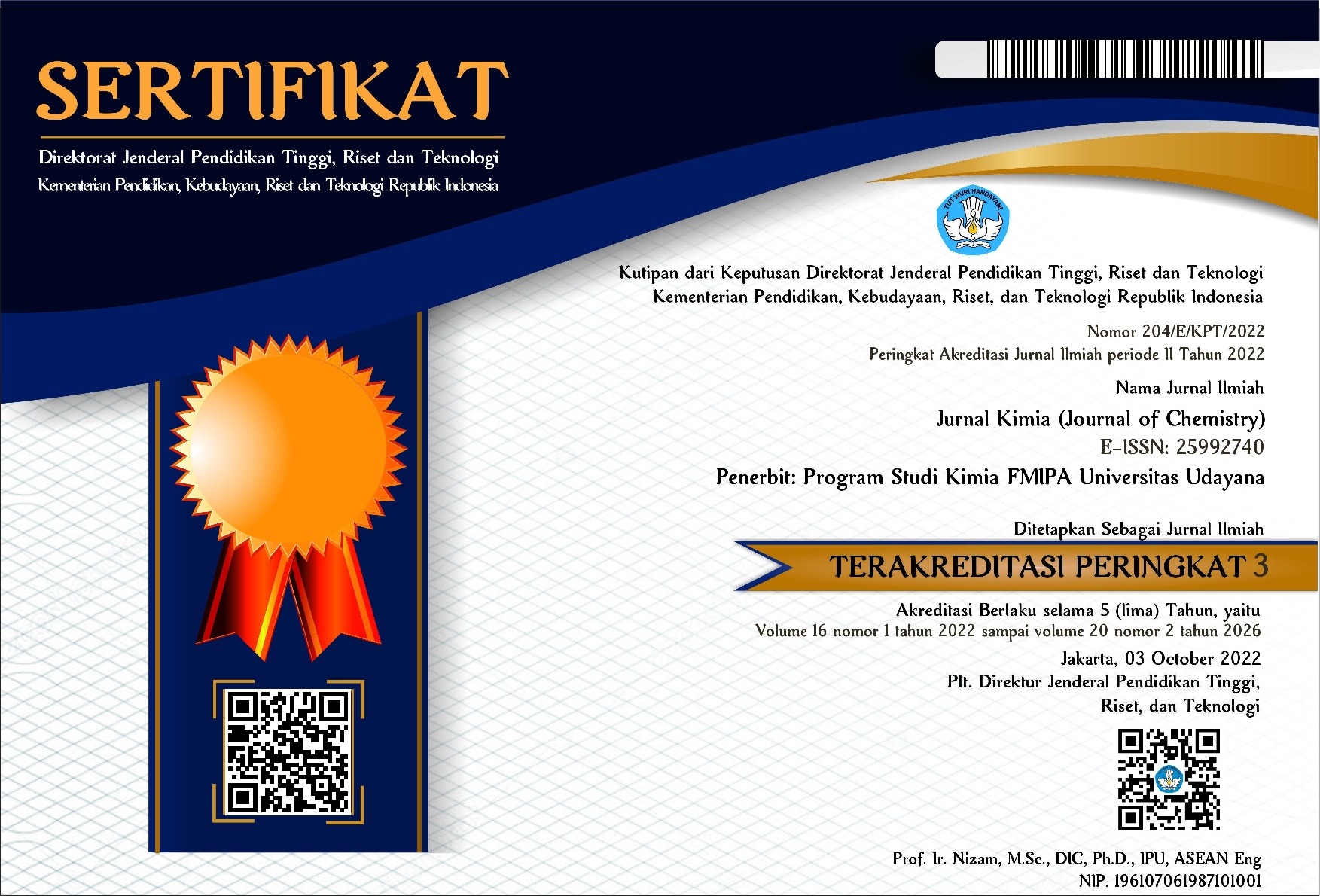ADSORPSI KLORAMFENIKOL METODE SOLID PHASE EXTRACTION (SPE) SEDERHANA PADA MOLECULARLY IMPRINTED POLYMER (MIP) DENGAN BERBASIS REAKSI DIAZOTASI
Abstract
Molecularly Imprinted Polymers (MIP) adalah polimer sintetis yang memiliki kemampuan untuk mengenali molekul targetnya secara spesifik. Pada penelitian ini MIP digunakan sebagai adsorben untuk penyerapan kloramfenikol dengan metode adsorpsi SPE sederhana. Proses sintesis dilakukan dengan metode polimerisasi presipitasi dengan perbandingan template, monomer, dan cross-linker sebesar 1:3:18 mmol.Penelitian ini bertujuan untuk mengetaui karakteristik MIP yang diuji dengan instrument FTIR untuk mendeteksi gugus fungsi -NO2 dan SEM untuk menunjukkan struktur permukaan dan melihat rongga dari MIP serta mengetahui besarnya kapasitas pada metode SPE sederhana yang diterapkan pada adsorpsi dengan MIP sebagai adsorben. Pengujan dilakukan dengan menggunakan prinsip reaksi diazotasi. Pengujian kapasitas adsorpsi dilakukan pada konsentrasi 10, 25, 50, 75, dan 100 ppm. Hasil penelitian menunjukkan kapasitas adsorpsi paling besar 10,157 mg/g. Hasil analisa FTIR menunjukkan gugus NO2 pada NIP tedapat pada bilangan gelombang 1536 cm-1 dan puncak tersebut hilang pada MIP menunjukkan bahwa kloramfenikol berhasil terekstrak. Dari hasil analisis yang dilakukan, metode SPE sederhana dapat dijadikan alternatif untuk metode adsorpsi dengan MIP sebagai adsorben.
Kata kunci:
adsorpsi, kloramfenikol, SPE, MIP, diazotasi
ABSTRACT
Molecularly Imprinted Polymers (MIPs) are synthetic polymers that can specifically recognize their target molecules. In this study, MIP was used as an adsorbent for chloramphenicol sorption by a simple SPE adsorption method. The synthesis process was carried out using the precipitation polymerization method with a template, monomer, and cross-linker ratio of 1:3:18 mmol. This study aimed to determine the characteristics of MIP analyzed by FTIR to detect the presence of -NO2 group. Functional groups and SEM were carried out to show the surface structure, the cavity of MIP, and also to determine the capacity in a simple SPE method applied to adsorption. The test was conducted using the principle of diazotation reaction. Adsorption was conducted at concentrations of 10, 25, 50, 75, and 100 ppm. The results showed that the largest adsorption capacity was 10.157 mg/g. The results of FTIR analysis showed that the NO2 group in NIP was detected at a wavenumber of 1536 cm-1. And the peak disappeared in MIP, indicating that chloramphenicol was successfully extracted. The analysis results showed that the simple SPE method can be used as an alternative to the adsorption method with MIP as the adsorbent.
Keywords:
adsorption, chloramphenicol, SPE, MIP, diazotation
Downloads
References
Alrassol, K. S. A., AL-Salman, H. N. K., Jasim, E. Q., & Hussein, H. H. (2020). Determination and Evaluation of Doses of Metronidazole in Different Quantities and Formulations with Multiple Spectroscopic Methods. Systematic Reviews in Pharmacy, 11(05). https://doi.org/10.31838/srp.2020.5.21
Commision Decision EU. (2005). Laying Down Harmonized Standards For The Testing For Certain Residues In Product Of Animal Origin Imported From Third Countries. Official Journal of the European Union.
Juliana, M., & Yulian, M. (2020). Identifikasi Kloramfenikol pada Udang Vaname (Litopenaeus Vannamei) Menggunakan High Performance Liquid Chromatography (HPLC).
Khudzaifah, N. A., & Basukiwardojo, M. M. S. (2022). Determination of the optimum concentration of the coupling agent in chloramphenicol analysis. World Journal of Advanced Research and Reviews, 15(1), 525–533. https://doi.org/10.30574/wjarr.2022.15.1.0719
Purwitasari, D. G., Tussania, R., & Fathoni, R. (2022). Adsorpsi Logam Kadmium (Cd) pada Kadmium Sulfat (CdSO4) Menggunakan Batang Pohon Pisang Sebagai Adsorben. Jurnal Chemurgy, 6(1), 52. https://doi.org/10.30872/cmg.v6i1.7905
Sajini, T., & Mathew, B. (2021). A brief overview of molecularly imprinted polymers: Highlighting computational design, nano and photo-responsive imprinting. Talanta Open, 4, 100072. https://doi.org/10.1016/j.talo.2021.100072
Sari, J. M., & Hafiludin, H. (2023). Analisis Kadar Residu Antibiotik Kloramfenikol Pada Udang Vannamei (Litopenaeus Vannamei) Di Kabupaten Bangkalan Dengan Metode Elisa (Enzym Link Immunosorbent Assay). Juvenil:Jurnal Ilmiah Kelautan dan Perikanan, 4(2), 84–89. https://doi.org/10.21107/juvenil.v4i2.18075
Sianita, 2018. “Pengembangan Metode Analisis Kloramfenikol Dalam Akuakultur Secara Fotometrik Menggunakan Molecular Imprinted Polymer (Mip) Sebagai Adsorben. Disertasi. Universitas Airlangga (Online)
Stone, J. (2017). Sample Preparation Techniques for Mass Spectrometry in the Clinical Laboratory Chapter 3. Academic Press.
Tristi, J., & Muchtaridi, M. (2018). Review: Molecularly Imprinted Polymer (MIP) untuk Isolasi Atenolol dalam Sampel Biologis. 16.
Wang, Y., Zhang, W., Mhungu, F., Zhang, Y., Liu, Y., Li, Y., Luo, X., Pan, X., Huang, J., Zhong, X., Song, S., Li, H., Liu, Y., & Chen, K. (2021). Probabilistic Risk Assessment of Dietary Exposure to Chloramphenicol in Guangzhou, China. International Journal of Environmental Research and Public Health, 18(16), 8805. https://doi.org/10.3390/ijerph18168805
Wijayanti, I. E., & Kurniawati, E. A. (2019). Studi Kinetika Adsorpsi Isoterm Persamaan Langmuir dan Freundlich pada Abu Gosok sebagai Adsorben. EduChemia (Jurnal Kimia dan Pendidikan), 4(2), 175. https://doi.org/10.30870/educhemia.v4i2.6119
Xie, Y., Hu, Q., Zhao, M., Cheng, Y., Guo, Y., Qian, H., & Yao, W. (2018). Simultaneous Determination of Erythromycin, Tetracycline, and Chloramphenicol Residue in Raw Milk by Molecularly Imprinted Polymer Mixed with Solid-Phase Extraction. Food Analytical Methods, 11(2), 374–381. https://doi.org/10.1007/s12161-017-1008-x
Zhang, S., Li, S., Lei, M., & Han, Z. (2018). Online Enrichment Combined with High Performance Liquid Chromatography for Quantitation of Trace-level Chloramphenicol in Milk. Food Science and Technology Research, 24(6), 963–969. https://doi.org/10.3136/fstr.24.963

This work is licensed under a Creative Commons Attribution 4.0 International License





